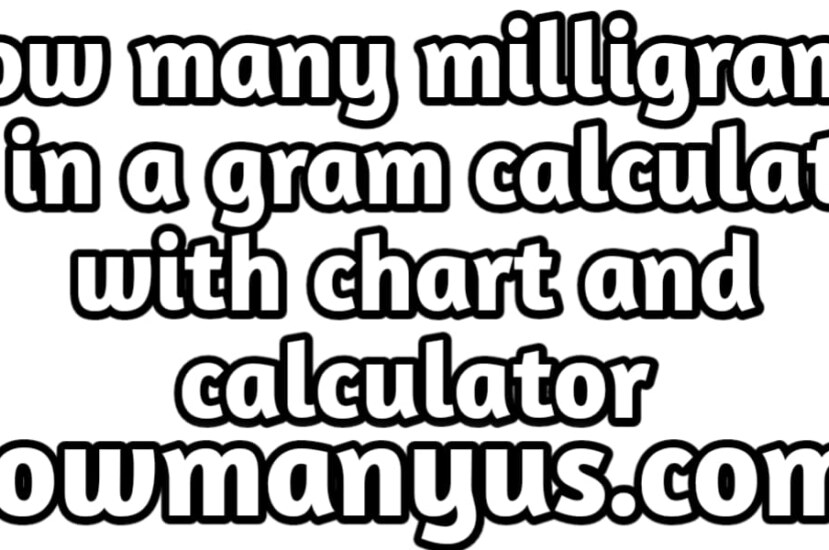1 gram to mg
1 gram to mg Introduction: Accurate measurement is a cornerstone of many fields, from cooking and pharmaceuticals to scientific research. In this blog post, we will delve deeper into the conversion of 1 gram to milligrams (mg). Understanding this conversion allows for precise measurements when dealing with smaller quantities. By exploring the intricacies of 1 gram to milligrams conversion, we can enhance our understanding of units and streamline our measurement processes. Let’s explore this topic further!
Grams/Milligrams Converter

- 1 gram to mg Establishing the Conversion Factor: To convert grams to milligrams, it is crucial to establish the conversion factor. The conversion factor between grams and milligrams is 1 gram equals 1000 milligrams. This means that there are 1000 milligrams in 1 gram. The conversion factor remains consistent regardless of the specific gram value being converted.
- 1 gram to mg Simple Conversion Calculation: The process of converting 1 gram to milligrams is straightforward. To obtain the equivalent value in milligrams, we multiply the gram value by the conversion factor of 1000. For example, to convert 1 gram to milligrams, we perform the following calculation: 1 gram x 1000 = 1000 milligrams.
- 1 gram to mg Importance of Precision: Precision in measurements is crucial in many applications, such as pharmaceutical dosages, chemical experiments, and scientific research. Converting from grams to milligrams allows for a higher level of accuracy when working with smaller quantities. The ability to measure in milligrams enables precise formulation of medications, accurate analysis of substances, and consistent results in scientific experiments.
- 1 gram to mg Practical Applications: The conversion of 1 gram to milligrams finds practical applications in various fields. In the pharmaceutical industry, medication dosages are often prescribed in milligrams. By converting grams to milligrams, healthcare professionals can ensure the accurate administration of medications to patients, taking into account precise dosage requirements.
1 gram to mg In scientific research, particularly in chemistry and biology, precise measurements are essential. Substances or reagents may need to be measured in milligrams to ensure accurate mixing, experimentation, and analysis. The conversion of grams to milligrams facilitates consistency in research protocols and allows for reproducible results.
Culinary pursuits also benefit from the conversion of grams to milligrams. Some recipes may require small quantities of ingredients, especially in baking or seasoning dishes. Converting grams to milligrams ensures precise measurements, leading to accurate flavor profiles and desired culinary outcomes.
- 1 gram to mg Ease of Conversion and Online Tools: The conversion of 1 gram to milligrams is a straightforward process once the conversion factor is understood. With a consistent conversion factor of 1000, the conversion can be applied to any gram value. However, for convenience and efficiency, online conversion tools are readily available. These tools allow for quick and accurate conversions by simply inputting the gram value, providing instant results in milligrams.
- Maintaining Consistency in Unit Conversions: Consistency in unit conversions is vital for accurate measurements. When converting from grams to milligrams, it is important to maintain consistency in the units being used throughout calculations. For example, if you have a measurement in kilograms (kg) that needs to be converted to milligrams, you must first convert the kilogram to grams (since there are 1000 grams in a kilogram) and then further convert grams to milligrams using the 1 gram to 1000 milligrams conversion factor.
- By consistently applying the appropriate conversion factors, you can avoid errors and ensure that your measurements are precise and reliable. Double-checking your conversions and reviewing the units at each step will help maintain accuracy and prevent any miscalculations.
- 1 gram to mg Understanding the Scale: One of the key reasons for converting grams to milligrams is to work with smaller measurements that require greater precision. The milligram scale allows for more detailed and accurate measurements, especially when dealing with substances or ingredients in minimal quantities.
- 1 gram to mg Having a good grasp of the conversion from grams to milligrams enables you to navigate this smaller scale effectively. Whether you are measuring medication dosages, chemical concentrations, or fine culinary ingredients, understanding the milligram scale allows for a finer level of control and precision in your work.
- 1 gram to mg Rounding and Significant Figures: When converting grams to milligrams, it’s important to consider rounding and significant figures. Typically, it’s advisable to round the converted milligram value to the appropriate number of significant figures based on the original measurement.
- For example, if the original measurement was 1.234 grams, the converted milligram value would be 1234 milligrams. However, if the original measurement was 1.2 grams, the converted milligram value would be 1200 milligrams.
- By being mindful of rounding and significant figures, you can maintain the appropriate level of precision in your measurements, reflecting the accuracy of the original value.
1 gram to mg Conclusion: Mastering the conversion of 1 gram to milligrams enables precision in measurements across various fields. Whether in pharmaceuticals, scientific research, or culinary endeavors, understanding this conversion factor of 1000 empowers professionals to achieve accuracy and consistency. Embrace this knowledge and unlock the potential for precise measurements in your area of expertise.



Leave a comment